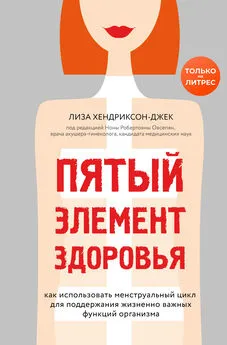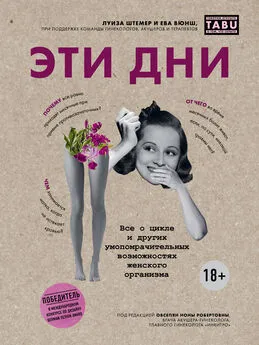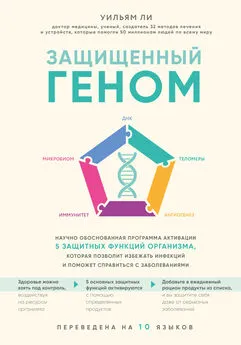Лиза Хендриксон-Джек - Пятый элемент здоровья. Как использовать менструальный цикл для поддержания жизненно важных функций организма
- Название:Пятый элемент здоровья. Как использовать менструальный цикл для поддержания жизненно важных функций организма
- Автор:
- Жанр:
- Издательство:Литагент 5 редакция
- Год:2020
- Город:Москва
- ISBN:978-5-04-104425-1
- Рейтинг:
- Избранное:Добавить в избранное
-
Отзывы:
-
Ваша оценка:
Лиза Хендриксон-Джек - Пятый элемент здоровья. Как использовать менструальный цикл для поддержания жизненно важных функций организма краткое содержание
«Почти» – потому что у женщин есть пятый показатель здоровья, на который, к сожалению, все еще мало кто обращает внимание, – это менструальный цикл. Короткий или длинный, регулярный или непредсказуемый – цикл может быть очень разным, и каждый его параметр, каждое изменение служат индикатором той или иной проблемы в организме. Планируете вы беременность или нет, овуляция имеет значение для поддержания здоровья.
Автор этой книги расскажет, что именно влияет на состояние менструального цикла, и научит вас составлять его график для максимально точного и удобного отслеживания различных изменений и контроля здоровья.
Пятый элемент здоровья. Как использовать менструальный цикл для поддержания жизненно важных функций организма - читать онлайн бесплатно ознакомительный отрывок
Интервал:
Закладка:
15. Abraham, G.E., and R.E. Rumley. “Role of nutrition in managing the premenstrual tension syndromes.” The Journal of Reproductive Medicine 32, no. 6 (1987): 405–422.
16. Head, Kathleen A. “Premenstrual syndrome: nutritional and alternative approaches.” Alternative Medicine Review 2, no. 1 (1997): 12–25; White, Colin P., Christine L. Hitchcock, Yvette M. Vigna, and Jerilynn C. Prior. “Fluid retention over the menstrual cycle: 1-year data from the prospective ovulation cohort.” Obstetrics and Gynecology International 2011 (2011): 1–7.
17. Abraham, G.E. “Nutritional factors in the etiology of the premenstrual tension syndromes.” The Journal of Reproductive Medicine 28, no. 7 (1983): 446–464; Schrier, Robert W. “Water and sodium retention in edematous disorders: role of vasopressin and aldosterone.” The American Journal of Medicine 119, no. 7 (2006): S47–S53.
18. Abraham, G.E., and R.E. Rumley. “Role of nutrition in managing the premenstrual tension syndromes.” The Journal of Reproductive Medicine 32, no. 6 (1987): 405–422; Dean, Carolyn, Susan K. Steinberg, and William H. Sylvester. “Medical Management of Premenstrual Syndrome.” Canadian Family Physician 32 (1986): 841– 852.
19. Abraham, G.E., and R.E. Rumley. “Role of nutrition in managing the premenstrual tension syndromes.” The Journal of Reproductive Medicine 32, no. 6 (1987): 405–422.
20. Halbreich, Uriel, Jeff Borenstein, Terry Pearlstein, and Linda S. Kahn. “The prevalence, impairment, impact, and burden of premenstrual dysphoric disorder (PMS/PMDD).” Psychoneuroendocrinology 28 (2003): 1–23.
21. Chocano-Bedoya, P.O., J.E. Manson, S.E. Hankinson, W.C. Willett, S.R. Johnson, L. Chasan-Taber, A.G. Ronnenberg, C. Bigelow, and E.R. Bertone-Johnson. “Dietary B vitamin intake and incident premenstrual syndrome.” The American Journal of Clinical Nutrition 93, no. 5 (2011): 1080–1086; Abraham, G.E., and R.E. Rumley. “Role of nutrition in managing the premenstrual tension syndromes.” The Journal of Reproductive Medicine 32, no. 6 (1987): 405–422.
22. Dexter, James D., John Roberts, and John A. Byer. “The five hour glucose tolerance test and effect of low sucrose diet in migraine.” Headache: The Journal of Head and Face Pain 18, no. 2 (1978): 91–94.
23. Kim, S.-Y., H.-J. Park, H. Lee, and H. Lee. “Acupuncture for premenstrual syndrome: a systematic review and meta-analysis of randomised controlled trials.” BJOG: An International Journal of Obstetrics & Gynaecology 118, no. 8 (2011): 899–915; Taguchi, Reina, Shigeki Matsubara, Sazu Yoshimoto, Kenji Imai, Akihide Ohkuchi, and Hiroshi Kitakoji. “Acupuncture for premenstrual dysphoric disorder.” Archives of Gynecology and Obstetrics 280, no. 6 (2009): 877–881; Habek, Dubravko, Jasna Čerkez Habek, and Ante Barbir. “Using acupuncture to treat premenstrual syndrome.” Archives of Gynecology and Obstetrics 267, no. 1 (2002): 23–26.
24. Appleton, Sarah M. “Premenstrual syndrome: evidence-based evaluation and treatment.” Clinical Obstetrics and Gynecology 61, no. 1 (2018): 52–61.
25. Walker, Ann F., Miriam C. De Souza, Michael F. Vickers, Savitri Abeyasekera, Marilyn L. Collins, and Luzia A. Trinca. “Magnesium supplementation alleviates premenstrual symptoms of fluid retention.” Journal of Women’s Health 7, no. 9 (1998): 1157–1165; Abraham, G.E., and R.E. Rumley. “Role of nutrition in managing the premenstrual tension syndromes.” The Journal of Reproductive Medicine 32, no. 6 (1987): 405–422; Mauskop, Alexander, and Jasmine Varughese. “Why all migraine patients should be treated with magnesium.” Journal of Neural Transmission 119, no. 5 (2012): 575–579; Mauskop, Alexander, Bella T. Altura, Roger Q. Cracco, and Burton M. Altura. “Intravenous magnesium sulphate relieves migraine attacks in patients with low serum ionized magnesium levels: a pilot study.” Clinical Science 89, no. 6 (1995): 633–636; Köseoglu, Emel, Abdullah Talaslıoglu, Ali Saffet Gönül, and Mustafa Kula. “The effects of magnesium prophylaxis in migraine without aura.” Magnesium Research 21, no. 2 (2008): 101–108; Facchinetti, Fabio, Grazia Sances, Paola Borella, Andrea R. Genazzani, and Giuseppe Nappi. “Magnesium prophylaxis of menstrual migraine: effects on intracellular magnesium.” Headache: The Journal of Head and Face Pain 31, no. 5 (1991): 298–301; Mauskop, Alexander, Bella T. Altura, Roger Q. Cracco, and Burton M. Altura. “Intravenous magnesium sulfate rapidly alleviates headaches of various types.” Headache: The Journal of Head and Face Pain 36, no. 3 (1996): 154–160; Mauskop, Alexander, Bella T. Altura, and Burton M. Altura. “Serum ionized magnesium levels and serum ionized calcium/ionized magnesium ratios in women with menstrual migraine.” Headache: The Journal of Head and Face Pain 42, no. 4 (2002): 242–248; Sarchielli, Paola, Giuliana Coata, Caterina Firenze, Piero Morucci, Giuseppe Abbritti, and Virgilio Gallai. “Serum and salivary magnesium levels in migraine and tension-type headache: results in a group of adult patients.” Cephalalgia 12, no. 1 (1992): 21–27.
26. Chocano-Bedoya, Patricia O., JoAnn E. Manson, Susan E. Hankinson, Walter C. Willett, Susan R. Johnson, Lisa Chasan-Taber, Alayne G. Ronnenberg, Carol Bigelow, and Elizabeth R. Bertone-Johnson. “Dietary B vitamin intake and incident premenstrual syndrome.” The American Journal of Clinical Nutrition 93, no. 5 (2011): 1080–1086; Abraham, G.E., and R.E. Rumley. “Role of nutrition in managing the premenstrual tension syndromes.” The Journal of Reproductive Medicine 32, no. 6 (1987): 405–422; Kashanian, M., R. Mazinani, and S. Jalalmanesh. “Pyridoxine (vitamin B6) therapy for premenstrual syndrome.” International Journal of Gynecology & Obstetrics 96, no. 1 (2007): 43–44; Wyatt, Katrina M., Paul W. Dimmock, Peter W. Jones, and P.M. Shaughn O’Brien. “Efficacy of vitamin B6 in the treatment of premenstrual syndrome: systematic review.” The BMJ 318, no. 7195 (1999): 1375–1381; Doll, Helen, Susan Brown, Amanda Thurston, and Martin Vessey. “Pyridoxine (vitamin B6) and the premenstrual syndrome: a randomized crossover trial.” The Journal of the Royal College of General Practitioners 39, no. 326 (1989): 364–368.
27. Schoenfield, Pam. “Vitamin B6, the under-appreciated vitamin.” The Weston A. Price Foundation. Accessed May 2, 2017. https://www.westonaprice.org/health-topics/abcs-of-nutrition/vitamin-b6-the-under-appreciated-vitamin/.
28. Kia, Afsaneh Saeedian, Reza Amani, and Bahman Cheraghian. “The association between the risk of premenstrual syndrome and vitamin D, calcium, and magnesium status among university students: a case control study.” Health Promotion Perspectives 5, no. 3 (2015): 225–230; Penland, James G., and Phyllis E. Johnson. “Dietary calcium and manganese effects on menstrual cycle symptoms.” American Journal of Obstetrics and Gynecology 168, no. 5 (1993): 1417–1423; Thys-Jacobs, Susan, Paul Starkey, Debra Bernstein, Jason Tian, and Premenstrual Syndrome Study Group. “Calcium carbonate and the premenstrual syndrome: effects on premenstrual and menstrual symptoms.” American Journal of Obstetrics and Gynecology 179, no. 2 (1998): 444–452; Ghanbari, Zinat, Fedieh Haghollahi, Mamak Shariat, Abbas Rahimi Foroshani, and Maryam Ashrafi. “Effects of calcium supplement therapy in women with premenstrual syndrome.” Taiwanese Journal of Obstetrics and Gynecology 48, no. 2 (2009): 124–129; Shobeiri, Fatemeh, Fahimeh Ezzati Araste, Reihaneh Ebrahimi, Ensiyeh Jenabi, and Mansour Nazari. “Effect of calcium on premenstrual syndrome: a double-blind randomized clinical trial.” Obstetrics & Gynecology Science 60, no. 1 (2017): 100–105; Takashima-Uebelhoer, B.B., and E.R. Bertone-Johnson. (2014). “Calcium intake and premenstrual syndrome.” Handbook of Diet and Nutrition in the Menstrual Cycle, Periconception and Fertility. Wageningen, Netherlands: Wageningen Academic Publishers, 51–65.
29. Thys-Jacobs, Susan, Don McMahon, and John P. Bilezikian. “Cyclical changes in calcium metabolism across the menstrual cycle in women with premenstrual dysphoric disorder.” The Journal of Clinical Endocrinology & Metabolism 92, no. 8 (2007): 2952–2959; Lehtovirta, P., D. Apter, and U.-H.. Stenman. “Serum CA-125 levels during the menstrual cycle.” Obstetrical & Gynecological Survey 46, no. 4 (1991): 245–246; Puskulian, Louiza. “Salivary electrolyte changes during the normal menstrual cycle.” Journal of Dental Research 51, no. 5 (1972): 1212–1216.
30. Thys-Jacobs, Susan, Paul Starkey, Debra Bernstein, Jason Tian, and Premenstrual Syndrome Study Group. “Calcium carbonate and the premenstrual syndrome: effects on premenstrual and menstrual symptoms.” American Journal of Obstetrics and Gynecology 179, no. 2 (1998): 444–452; Penland, James G., and Phyllis E. Johnson. “Dietary calcium and manganese effects on menstrual cycle symptoms.” American Journal of Obstetrics and Gynecology 168, no. 5 (1993): 1417–1423; Ghanbari, Zinat, Fedieh Haghollahi, Mamak Shariat, Abbas Rahimi Foroshani, and Maryam Ashrafi. “Effects of calcium supplement therapy in women with premenstrual syndrome.” Taiwanese Journal of Obstetrics and Gynecology 48, no. 2 (2009): 124–129; Shobeiri, Fatemeh, Fahimeh Ezzati Araste, Reihaneh Ebrahimi, Ensiyeh Jenabi, and Mansour Nazari. “Effect of calcium on premenstrual syndrome: a double-blind randomized clinical trial.” Obstetrics & Gynecology Science 60, no. 1 (2017): 100–105.
31. Thys-Jacobs, Susan, Paul Starkey, Debra Bernstein, Jason Tian, and Premenstrual Syndrome Study Group. “Calcium carbonate and the premenstrual syndrome: effects on premenstrual and menstrual symptoms.” American Journal of Obstetrics and Gynecology 179, no. 2 (1998): 444–452.
32. Michaëlsson, Karl, Håkan Melhus, Eva Warensjö Lemming, Alicja Wolk, and Liisa Byberg. “Long term calcium intake and rates of all cause and cardiovascular mortality: community based prospective longitudinal cohort study.” The BMJ 346 (2013): f228.
33. Там же.
34. Douglass II, William Campbell. (2007). The Raw Truth About Milk: How Science Is Destroying Nature’s Nearly Perfect Food and Why Animal Protein and Animal Fat in Your Diet Can Save Your Life. Republic of Panama: Rhino Publishing, 17; Magee, Hugh Edward, and Douglas Harvey. “Studies on the effect of heat on milk: some physico-chemical changes induced in milk by heat.” Biochemical Journal 20, no. 4 (1926): 873–884; Vasbinder, Astrid Jolanda. “Casein-whey protein interactions in heated milk.” PhD dissertation, 2003. Accessed May 7, 2017. dspace.library.uu.nl/bitstream/handle/1874/765/full.pdf.
35. Thys-Jacobs, Susan. “Micronutrients and the premenstrual syndrome: the case for calcium.” Journal of the American College of Nutrition 19, no. 2 (2000): 220–227; Saeedian Kia A., R. Amani, and B. Cheraghian. “The association between the risk of premenstrual syndrome and vitamin D, calcium, and magnesium status among university students: a case control study.” Health Promotion Perspectives 5, no. 3 (2015): 225–230.
36. Schmid, Alexandra, and Barbara Walther. “Natural vitamin D content in animal products.” Advances in Nutrition: An International Review Journal 4, no. 4 (2013): 453–462; Ovesen, Lars, Rikke Andersen, and Jette Jakobsen. “Geographical differences in vitamin D status, with particular reference to European countries.” Proceedings of the Nutrition Society 62, no. 04 (2003): 813–821.
37. Nair, Rathish, and Arun Maseeh. “Vitamin D: the ‘sunshine’ vitamin.” Journal of Pharmacology and Pharmacotherapeutics 3, no. 2 (2012): 118–126.
38. Mead, M. Nathaniel. “Benefits of sunlight: a bright spot for human health.” Environmental Health Perspectives 116, no. 4 (2008): A160–167.
Читать дальшеИнтервал:
Закладка:









